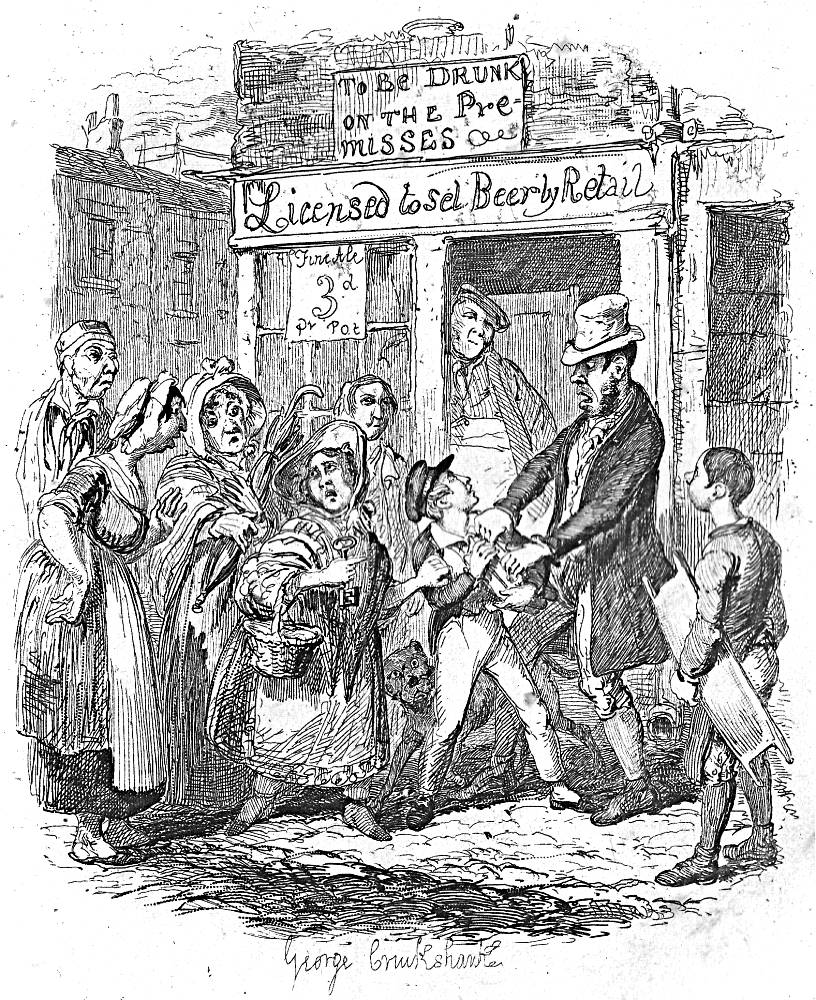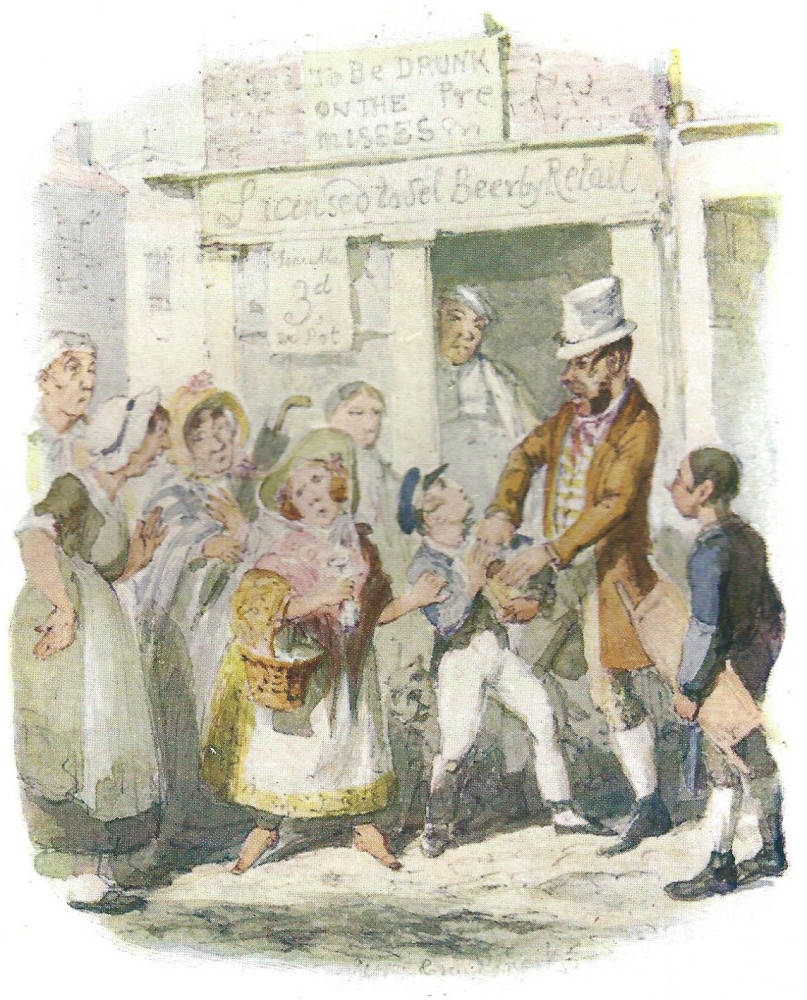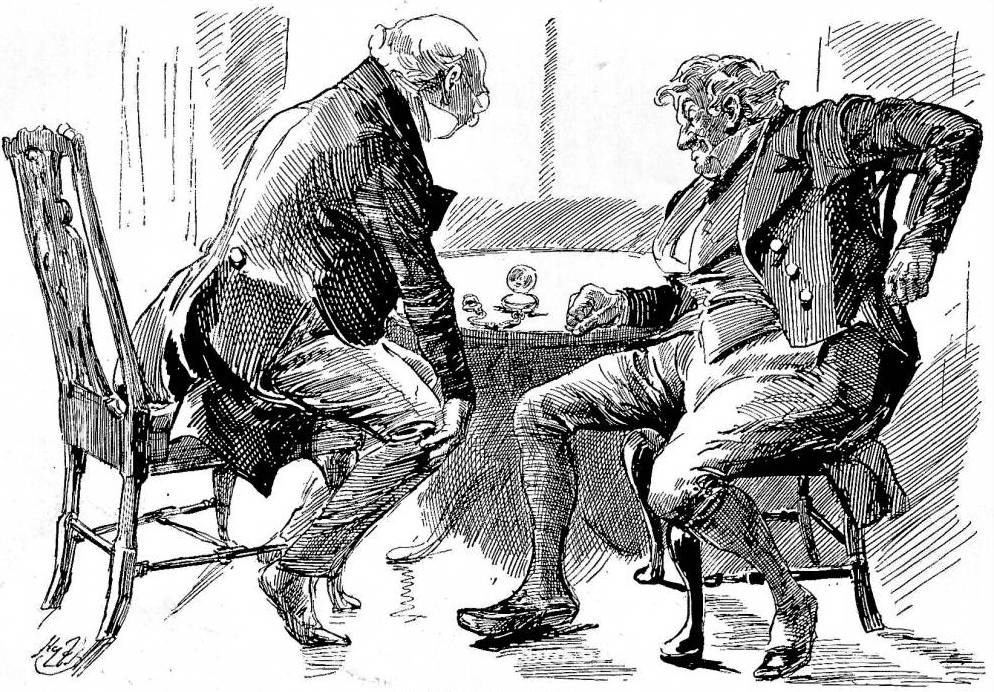

Oliver claimed by his affectionate friends — the seventh steel engraving and later a watercolour for Charles Dickens's The Adventures of Oliver Twist; or, The Parish Boy's Progress, first published in volume by Richard Bentley after its September 1837 appearance in Bentley's Miscellany, Chapter XV. 4 ½ by 3 ¾ inches (11.4 cm by 9.3 cm), vignetted, facing page 82 in the 1846 edition (originally leading off the seventh monthly instalment). Cruikshank's own 1866 watercolour, commissioned by F. W. Cosens, is the basis for the 1911 chromolithograph. [Click on the images to enlarge them.]
Passage Illustrated: Sikes and Nancy recapture Oliver
Meanwhile, Oliver Twist, little dreaming that he was within so very short a distance of the merry old gentleman, was on his way to the book-stall. When he got into Clerkenwell, he accidentally turned down a by-street which was not exactly in his way; but not discovering his mistake until he had got half-way down it, and knowing it must lead in the right direction, he did not think it worth while to turn back; and so marched on, as quickly as he could, with the books under his arm.
He was walking along, thinking how happy and contented he ought to feel; and how much he would give for only one look at poor little Dick, who, starved and beaten, might be weeping bitterly at that very moment; when he was startled by a young woman screaming out very loud. "Oh, my dear brother!" And he had hardly looked up, to see what the matter was, when he was stopped by having a pair of arms thrown tight round his neck.
"Don't," cried Oliver, struggling. "Let go of me. Who is it? What are you stopping me for?"
The only reply to this, was a great number of loud lamentations from the young woman who had embraced him; and who had a little basket and a street-door key in her hand.
"Oh my gracious!" said the young woman, "I have found him! Oh! Oliver! O liver! Oh you naughty boy, to make me suffer such distress on your account! Come home, dear, come. Oh, I've found him. Thank gracious goodness heavins, I've found him!" With these incoherent exclamations, the young woman burst into another fit of crying, and got so dreadfully hysterical, that a couple of women who came up at the moment asked a butcher's boy with a shiny head of hair anointed with suet, who was also looking on, whether he didn't think he had better run for the doctor. To which, the butcher's boy: who appeared of a lounging, not to say indolent disposition: replied, that he thought not.
"Oh, no, no, never mind," said the young woman, grasping Oliver's hand; "I'm better now. Come home directly, you cruel boy! Come!"
"Oh, ma'am," replied the young woman, "he ran away, near a month ago, from his parents, who are hard-working and respectable people; and went and joined a set of thieves and bad characters; and almost broke his mother's heart."
"Young wretch!" said one woman.
"Go home, do, you little brute," said the other.
"I am not," replied Oliver, greatly alarmed. "I don't know her. I haven't any sister, or father and mother either. I'm an orphan; I live at Pentonville."
"Only hear him, how he braves it out!" cried the young woman.
"Why, it's Nancy!" exclaimed Oliver; who now saw her face for the first time; and started back, in irrepressible astonishment.
"You see he knows me!" cried Nancy, appealing to the bystanders. "He can't help himself. Make him come home, there's good people, or he'll kill his dear mother and father, and break my heart!"
"What the devil's this?" said a man, bursting out of a beer-shop, with a white dog at his heels; "young Oliver! Come home to your poor mother, you young dog! Come home directly."
"I don't belong to them. I don't know them. Help! help!" cried Oliver, struggling in the man's powerful grasp. [Chapter XV, "Showing How Very Fond of Oliver Twist, The Merry Old Jew and Miss Nancy Were," pp. 81-82 in the 1846 edition]
Commentary: The errant sheep taken back into the fold
Cruishank's realisation of the London street scene involves a masterful caricature of the local proletariate and in his backdrop the kinds of buildings one sees throughout the seamier numbers of his illustrations for "Streets" and "Scenes" in Sketches by Boz. Illustrative of every-day life and every-day people (1833-36). In the present steel-engraving, Cruikshank realises the gang's re-apprehension of Oliver after his idyllic sojourn with the kindly Mr. Brownlow. This dramatic "take-down" scene is also the subject of a much more realistic illustration by F. O. C. Darley in the Character Sketches from Dickens (1888). Undoubtedly Cruikshank's illustration was Darley's point of departure.
In the numbers of the serialised novel published serially between February 1837 and April 1839 in Bentley's Miscellany, Cruikshank depicts the brutal housebreaker Bill Sikes four times in the series of twenty-four plates. In both the original volume edition and the Household Edition (1871) Sikes is consistently the sordid, lower-class villain out of contemporary melodrama. On the other hand, the figure whom Felix Octavius Carr Darley describes in his series of Character Sketches from Dickens (1888) is once again much more of an individual (despite his characteristic long face and white top hat) than a type.
In Oliver claimed by his affectionate friends, the nine distorted, caricatural forms who surround Oliver outside the effectively realised beer-shop (complete with appropriate signage) compel the reader to identify with the only undistorted figure, who, by his upper-middle class, tailored suit alone, demonstrates the truth of his assertion that he does not belong to the unusually short, slatternly Nancy and the tall, brutish, ill-kempt common-law partner, Sikes. This, then, is a fundamentally "classist" view of the locale's dull-witted, working-class society, which Cruikshank intimates congregates in the streets, and frequents gin-palaces and beer-shops. By virtue of his height, which Cruikshank has accentuated by giving him a white top-hat, Sikes dominates the scene as he grabs the books out of Oliver's hands and Nancy plays to the female street chorus. Cruikshank appears to have been little interest in Sikes's faithful dog Bull's-eye, who peers out from under the fashionably-dressed Oliver, right of centre. Cruikshank clarifies which of the women is Nancy by giving the short woman in the big hat (left of centre) a basket and large key. The butcher's boy whom Dickens mentions is likely the figure to the right, as the other male (extreme left) is wearing the skull cap of a carpenter. Instead of a figure looking out of a garret window, Cruikshank has supplied the disinterested proprietor of the beer-shop (above centre). Surprising to modern readers, perhaps, is that just a few streets from the respectable shopping district in Clerkenwell known as "The Green" one might have encountered a beer-shop and such a disreputable cast of supporting street people.
Relevant Illustrations from later editions (1867, 1871, 1886, 1888, and 1910)



Left: Sol Eytinge, Junior's Diamond Edition dual character study Nancy and Bill Sikes. Centre: James Mahoney's Household Edition wood-engraving of Sikes and Nancy's discussing where Oliver might have gone: "You are on the scent, are you, Nancy?" (1871). Right: O. C. Darley's triple character study Sikes, Nancy, and Oliver Twist (1888).


Left: Harry Furniss's study of Brownlow and Grimwig, starting to worry because Oliver has failed to return from his errand: Waiting for Oliver (1910). Right: Oliver trapped by Nancy and Sikes (1910). [Click on the imagesto enlarge them.]
Various Interpretations of Bill Sikes, Housebreaker (1837-1910)
In the chapter 22 illustration which depicts Oliver's being surprised and shot at as soon as he has entered the suburban house that Sikes is attempting to rob, The Burglary, Cruikshank reintroduces the notorious housebreaker somewhat reduced, in a miniature framed portrait, as the impotent Sikes watches the unfolding scene with interest. Effectively rendered in each of his four appearances, Cruikshank's ruffian is unshaven, unkempt, and full-faced. Selecting an equally dramatic moment in the story, Darley depicts Bill Sikes in action, rather than as a static figure, whereas in the Diamond Edition of 1867, Sol Eytinge in Nancy and Bill Sikes captures the disreputable couple's desperation and despondency. In the Household Edition, realist James Mahoney focuses on a different aspect of the chapter entirely, depicting Fagin's chagrin at the Dodger and Charley's having lost Oliver on his first expedition out. In the 1910 Charles Dickens Library Edition, Furniss focusses on Sikes's re-apprehension of Oliver and, in contrast, on the two adults who wait anxiously for Oliver's return to the tranquil, upper-middle-class house in Pentonville, the optimistic Mr. Brownlow and his dour, pessimistic friend, Grimwig.
Related Material
- Nancy and Bill Sikes in various editions of Oliver Twist (1837-1910)
- Oliver Twist Illustrated, 1837-1910
- Early dramatic adaptations of Oliver Twist (1838-1842)
- Alternative Dickens: cartoon based on Cruikshank in Oliver Twist
Scanned images and text by Philip V. Allingham. [You may use these images without prior permission for any scholarly or educational purpose as long as you (1) credit the photographer and (2) link your document to this URL in a web document or cite the Victorian Web in a print one.]
Bibliography
Bentley, Nicolas, Michael Slater, and Nina Burgis. The Dickens Index. New York and Oxford: Oxford U. P., 1990.
Cohen, Jane Rabb. "George Cruikshank." Charles Dickens and His Original Illustrators. Columbus: Ohio State U. P., 1980. Pp. 15-38.
Darley, Felix Octavius Carr. Character Sketches from Dickens. Philadelphia: Porter and Coates, 1888.
Davis, Paul. Charles Dickens A to Z: The Essential Reference to His Life and Work. New York: Facts On File, 1998.
Dickens, Charles. The Adventures of Oliver Twist; or, The Parish Boy's Progress. Illustrated by George Cruikshank. London: Bradbury and Evans; Chapman and Hall, 1846.
_______. Oliver Twist. Works of Charles Dickens. Household Edition. 55 vols. Illustrated by F. O. C. Darley and John Gilbert. New York: Sheldon and Co., 1865.
_______. Oliver Twist. Works of Charles Dickens. Diamond Edition. 14 vols. Illustrated by Sol Eytinge, Jr. Boston: Ticknor and Fields, 1867.
_______. Oliver Twist. Works ofCharles Dickens. Household Edition. 22 vols. Illustrated by James Mahoney. London: Chapman and Hall, 1871. Vol. I.
_______. The Adventures of Oliver Twist. Works of Charles Dickens. Charles Dickens Library Edition. 18 vols. Illustrated by Harry Furniss. London: Educational Book Company, 1910. Vol. 3.
Forster, John. "Oliver Twist 1838." The Life of Charles Dickens. Ed. B. W. Matz. The Memorial Edition. 2 vols. Philadelphia: J. B. Lippincott, 1911. Vol. 1, book 2, chapter 3. Pp. 91-99.
Grego, Joseph (intro). Cruikshank's Water Colours. [27 Oliver Twist illustrations, including the wrapper and the 13-vignette title-page produced for F. W. Cosens; 20 plates for William Harrison Ainsworth's The Miser's Daughter: A Tale of the Year 1774; 20 plates plus the proofcover the work for W. H. Maxwell's History of the Irish Rebellion in 1798 and Emmetts Insurrection in 1803]. London: A & C Black, 1903. OT = pp. 1-106]. Book in the Rare Book Collection of the University of Toronto.
Kitton, Frederic G. "George Cruikshank." Dickens and His Illustrators: Cruikshank, Seymour, Buss, "Phiz," Cattermole, Leech, Doyle, Stanfield, Maclise, Tenniel, Frank Stone, Topham, Marcus Stone, and Luke Fildes. 1899. Rpt. Honolulu: U. Press of the Pacific, 2004. Pp. 1-28.
Lynch, Tony. "Clerkenwell, London." Dickens's England: An A-Z Tour of the Real and Imagined Locations. London: Batsford, 2012. Pp. 64-65.
Created 27 August 2014 Last modified 13 December 2021